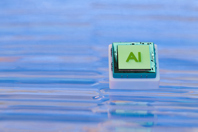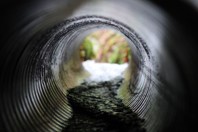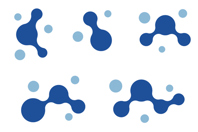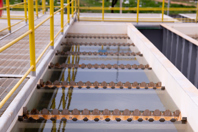WATER INNOVATIONS CURRENT ISSUE
-
Nobel-winning molecular materials are poised to reinvent purification, desalination, and reuse.
-
Water and wastewater utilities can get stuck in a cycle of upgrading their legacy operational technology systems. Here’s how to break that cycle.
-
Engineers are turning to AI to cut weeks of work into hours and sharpen critical decisions.
-
Strategic flow monitoring helps wastewater utilities curb overflows, cut costs, and safeguard public health by turning accurate data into proactive action.
-
From graphene membranes to metal nanoparticles, nanotechnology is reshaping water purification with faster, cleaner, and more energy-efficient solutions.
-
One of the most pressing challenges facing utilities today is how to effectively respond to surging industrial demands while managing costs and maintaining established levels of service to existing customers. Thanks to new funding sources and drivers such as AI, the landscape has changed dramatically in recent years. Industries such as data centers and semiconductors are consuming massive volumes of water to support cooling and manufacturing — and creating equally daunting challenges on the wastewater front.
-
When seeking bids for a fair comparison, it’s important to evaluate the total cost of ownership.
WASTEWATER
-
Pretreatment Filtration For Small Systems: The Expensive Pitfalls Of Low-Cost Equipment10/30/2025
When seeking bids for a fair comparison, it’s important to evaluate the total cost of ownership.
-
Designer Microbes: Can Synthetic Biology Supercharge Wastewater Treatment?7/3/2025
Exploring the potential of bioengineering as a pathway to pollution remediation.
-
CERCLA And PFAS: What's The Liability For Water And Wastewater Utilities?5/2/2025Federal rules aim to target those liable but may miss the mark. Utilities can redirect the effort — and costs — to those truly responsible for PFAS contamination.
-
8 Trends In Decentralized Wastewater Treatment: Shaping A Sustainable Future1/7/2025Centralized wastewater treatment is sometimes not an option — and sometimes simply not the best choice, considering the expanding capabilities of decentralized systems.
UTILITY MANAGEMENT
-
DOE Program To Extract Minerals And Nutrients From Wastewater Is Industry's Latest Sustainability Effort11/30/2025
The U.S. Department of Energy’s Advanced Research Projects Agency–Energy (ARPA-E) announced in early November its allocation of $25 million, spread across 10 different projects seeking economically viable ways to extract critical minerals and nutrients from wastewater.
-
From Data To Decisions: AI's New Role In Water Management10/30/2025Engineers are turning to AI to cut weeks of work into hours and sharpen critical decisions.
-
Converging Challenges, Unified Solutions: How Three Overlapping Trends Are Shaping Public Water9/5/2025
With the right help, coping with workforce upheaval, the digital transition, and asset management can be an opportunity.
INFRASTRUCTURE
-
The Hidden Costs Of Legacy Operational Technology10/30/2025
Water and wastewater utilities can get stuck in a cycle of upgrading their legacy operational technology systems. Here’s how to break that cycle.
-
Smarter Pumps, Lower Emissions: The Digital Reinvention Of San Jose Water9/5/2025
Pumps are power-hungry and thus expensive to run, but San Jose Water shows how data-driven technologies and strategies can bring the cost down for utilities.
-
Building Tomorrow's Water Infrastructure: Insights From The Pacific Northwest's Largest Water Conveyance Program7/3/2025
As water utilities across the country grapple with aging infrastructure, population growth, and increasing climate uncertainties, a major infrastructure initiative in the Pacific Northwest demonstrates effective approaches to meet these challenges.
SOURCE WATER
-
Common Misconceptions Are Keeping Lakes "Sick"9/5/2025
Long-held misconceptions about lake management fuel the intensity and recurrence of harmful algal blooms.
-
How Water Utilities Can Support The Electric Grid While Reducing Costs5/2/2025Orange County Water District is combining operational flexibility with environmental stewardship by participating in demand response, earning millions in payments while maintaining their commitment to delivering clean, reliable water.
-
New Arsenal For Algae Outbreaks3/6/2025How communities are protecting drinking water reservoirs without relying on chemicals.
DRINKING WATER
-
3 Nanotech Breakthroughs Revolutionizing Water Purification Worldwide10/30/2025From graphene membranes to metal nanoparticles, nanotechnology is reshaping water purification with faster, cleaner, and more energy-efficient solutions.
-
A Comprehensive Guide To Phosphate Feed System Design For Drinking Water Applications9/5/2025
Phosphate dosing systems are critical for corrosion control, and increasingly important under the mandate of Lead and Copper Rule Improvements.
-
PFAS Policy In 2025: Why It's Time To Go Beyond Remediation7/3/2025The most common techniques for disposing of PFAS may no longer be good enough.
FUNDING AND REVENUE
-
Public-Private Water Partnerships: Proactive Strategies For Industrial Water Challenges10/30/2025One of the most pressing challenges facing utilities today is how to effectively respond to surging industrial demands while managing costs and maintaining established levels of service to existing customers. Thanks to new funding sources and drivers such as AI, the landscape has changed dramatically in recent years. Industries such as data centers and semiconductors are consuming massive volumes of water to support cooling and manufacturing — and creating equally daunting challenges on the wastewater front.
-
How To Set Realistic Targets To Reduce Non-Revenue Water5/2/2025Data-gathering is key to goal-setting, and is achievable in 5 steps.
-
Modern Solutions For Aging Water Systems: AMI And Beyond1/7/2025
Lessons from two communities on the benefits of advanced metering infrastructure.
MEASUREMENT AND CONTROL
-
How To Strengthen Your Flow Monitoring Strategy … Before The Next Overflow10/30/2025
Strategic flow monitoring helps wastewater utilities curb overflows, cut costs, and safeguard public health by turning accurate data into proactive action.
-
Harnessing The Power Of Oxidation-Reduction Potential For Smarter Wastewater Management9/5/2025"Potential" is in the name. Here's what wastewater managers should know about both the benefits and challenges of ORP as an agent of process control.
-
From Theory To Precision: ORP Monitoring As The New Standard In Water Treatment7/3/2025On numerous levels, oxidation-reduction potential (ORP) outperforms the presently predominant metric for evaluating disinfection performance.
REUSE
-
How Santa Monica Became A Sustainable Water Leader7/3/2025Lessons in urban water management through water conservation, capture, and reuse.
-
How Water Reuse Projects Are Addressing Water Scarcity In The West — And Beyond3/6/2025As water scarcity becomes a stark reality around the globe, more municipalities, water utilities, and industrial enterprises are exploring water reuse projects and adopting regulations to support them. Fundamentally, water reuse can help drought-proof regions and diversify water supply portfolios with recycled water.
-
How Capturing Rain Can Contribute To Environmental Safety1/7/2025There are many ways to capture stormwater — whether as a homeowner, business, or municipality — and even more benefits.
-
Pioneering Recycling Program Quenches California's Thirst For Agricultural Water10/31/2024With its innovative Harvest Water program, the Sacramento Area Sewer District supports Central Valley growers, thereby supporting the nation.
FROM THE EDITOR
-
When Chemistry Meets Water Innovation10/30/2025
Nobel-winning molecular materials are poised to reinvent purification, desalination, and reuse.
-
Securing Smart Water9/5/2025
The digital transformation of utilities is necessary and inevitable but also innately vulnerable to bad actors. It's time to discuss prioritizing cybersecurity.
-
A New Power Paradigm For Wastewater Utilities?7/3/2025
Renewable energy is great for the environment. Are power purchase agreements great for wastewater treatment operations?
-
Building Back Better?5/2/2025
Every four years, America gets a fresh reminder of where we stand as a nation, for better or worse. What have we reaped this time around?
-
Cybersecurity For The Win: How Water Utilities Can Embrace Digital Technology3/6/2025
Water and wastewater system operators are known to be a careful lot. Tightly regulated by the U.S. EPA and state agencies — and committed to public health — they cannot afford mistakes. This often results in "tried-and-true" methodologies winning out over innovative solutions, but the incredible upside offered by digital technologies has encouraged a wave of cyber adoption. Almost cruelly, it comes with cyber threats.







